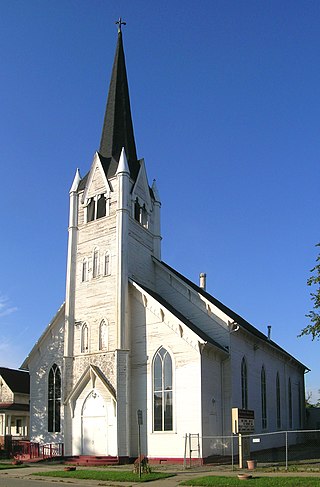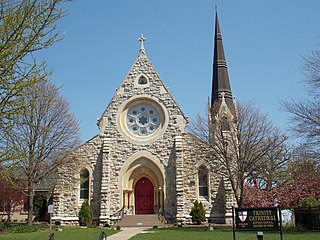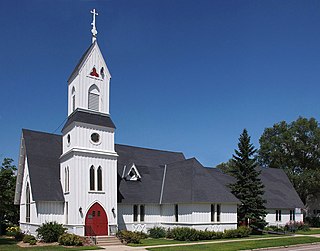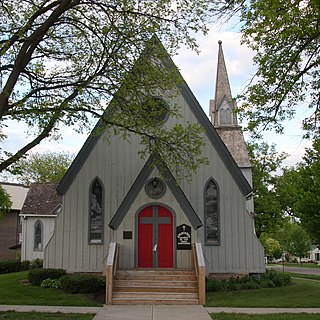
Carpenter Gothic, also sometimes called Carpenter's Gothic or Rural Gothic, is a North American architectural style-designation for an application of Gothic Revival architectural detailing and picturesque massing applied to wooden structures built by house-carpenters. The abundance of North American timber and the carpenter-built vernacular architectures based upon it made a picturesque improvisation upon Gothic a natural evolution. Carpenter Gothic improvises upon features that were carved in stone in authentic Gothic architecture, whether original or in more scholarly revival styles; however, in the absence of the restraining influence of genuine Gothic structures, the style was freed to improvise and emphasize charm and quaintness rather than fidelity to received models. The genre received its impetus from the publication by Alexander Jackson Davis of Rural Residences and from detailed plans and elevations in publications by Andrew Jackson Downing.

The Cathedral of Our Merciful Saviour in Faribault is the oldest cathedral in Minnesota. Built 1862–1869, it was the first church in the Episcopal Church in the United States of America designed as a cathedral. The architect was James Renwick Jr., who also designed St. Patrick's Cathedral in New York, the Smithsonian Institution Building in Washington, D.C., and a very similar church, the Christ Church by the Sea in Colón, Panama. On August 10, 1979, the cathedral and its guild house were added to the National Register of Historic Places. On February 19, 1982, there was a boundary increase to add the bishop's residence to the National Register.

Gethsemane Episcopal Church is an historic church in downtown Minneapolis, Minnesota, United States, listed on the National Register of Historic Places. It is one of the oldest extant churches in Minneapolis and is significant for its Gothic Revival architecture.

St. Andrew's Episcopal Church, also known as St. Andrew's Church is a historic church building on County Highway 12 in Prairieville, Alabama. Built by slaves in 1853, it is a remarkably well-preserved example of Carpenter Gothic architecture, its design apparently taken from a book by Richard Upjohn. St. Andrew's was added to the National Register of Historic Places on November 7, 1973, and was declared a National Historic Landmark on the same day. Public access is allowed to this National Historic Landmark.

The Church of the Redeemer is a historic Episcopal church located at 123 Third Street North in Cannon Falls in the U.S. state of Minnesota. The building was built with limestone and wood in 1867.

The All Saints Episcopal Church church building, a historic Carpenter Gothic structure at Hall and Harrison streets, in DeQuincy, Louisiana, was listed on the National Register of Historic Places in 1983. It was occupied by 'Grace Church', a non-denominational church in the United States. In 2022, it was turned over to a new pastor and in 2023 it was purchased by Set Free Fellowship Church, a non-denominational church.

The Gethsemane Evangelical Lutheran Church is a church located at 4461 Twenty-Eighth Street in Detroit, Michigan. It was designated a Michigan State Historic Site in 1980 and listed on the National Register of Historic Places in 1982. The building now houses the Motor City Missionary Baptist Church.

Trinity Episcopal Cathedral, formerly known as Grace Cathedral, is the historic cathedral in the Diocese of Iowa. The cathedral is located on the bluff overlooking Downtown Davenport, Iowa, United States. Completed in 1873, Trinity is one of the oldest cathedrals in the Episcopal Church in the United States. It was individually listed on the National Register of Historic Places in 1974. In 1983 the cathedral was included as a contributing property in the College Square Historic District, which is also listed on the National Register.

This is a list of the National Register of Historic Places listings in Swift County, Minnesota. It is intended to be a complete list of the properties and districts on the National Register of Historic Places in Swift County, Minnesota, United States. The locations of National Register properties and districts for which the latitude and longitude coordinates are included below, may be seen in an online map.

Gethsemane Lutheran Church is a historic Lutheran church in downtown Austin, Texas. Designated as a Recorded Texas Historic Landmark and listed on the National Register of Historic Places, the building currently holds offices of the Texas Historical Commission.

The Church of the Good Shepherd built in 1880 is an historic Episcopal church located at 331 Lake Avenue in Maitland, Orange County, Florida. Designed by renowned New York architect Charles C. Haight in the Carpenter Gothic style of architecture, it was built largely through the efforts of the Right Reverend Henry Benjamin Whipple, the first bishop of Minnesota, who began wintering in Maitland in the 1870s. Its board and batten exterior walls and lancet windows are typical of Carpenter Gothic architecture, but its belfry centered over the altar area is unusual. The church was consecrated on March 17, 1883, and Bishop Whipple conducted regular services there each winter for the rest of his life. In 1967, a new modern church designed by Nils M. Schweizer was built to complement the original structure, which since then has served as a chapel. On March 28, 2011, the 1880 church was added to the National Register of Historic Places.

Trinity Episcopal Church is an Episcopal church in Litchfield, Minnesota, United States, built in 1871 in Carpenter Gothic style. It has been attributed to the noted New York architect Richard Upjohn. It was listed on the National Register of Historic Places in 1975 for having local significance in the theme of architecture. It was nominated as a superlative example of Carpenter Gothic design from the mid-19th century.

Trinity Episcopal Church is a historic church building in Stockton, Minnesota, United States, constructed in 1859. It is now the Grace Evangelical Lutheran Church and was enlarged with a new wing in 1971. The original section was listed on the National Register of Historic Places in 1984 for having local significance in the themes of architecture and exploration/settlement. It was nominated for its well-preserved Carpenter Gothic architecture and shared importance to a community established by American-born settlers but later dominated by German immigrants.

Trinity Episcopal Church is a historic church building in St. Charles, Minnesota, United States, constructed in 1874. It was listed on the National Register of Historic Places in 1984 for having local significance in the theme of architecture. It was nominated for the high integrity of its Carpenter Gothic design, well preserved in both the exterior and interior.

Christ Episcopal Church is a historic church building in Benson, Minnesota, United States. It is Benson's oldest church, built in 1879 as part of the Episcopal Church's ambitious expansion into western Minnesota under Bishop Henry Benjamin Whipple.

Church of the Good Shepherd Episcopal, a notable example of Rural Gothic architecture located at Moore and 8th Streets in Blue Earth, Minnesota, is the oldest surviving church building in the community. As the congregation diminished in the 1970s regular worship services were eventually suspended; in 1981 its three remaining members donated the building to the Faribault County Historical Society. Since then the church has hosted seasonal ecumenical services, Christmas concerts, weddings, and funerals. It was added to the National Register in 1980.

Episcopal Church of Our Savior is a historic church at 113 4th Street NE in Little Falls, Minnesota, United States. The congregation was established around 1858, as a missionary effort by Bishop Henry Whipple, and they built their first building around that time. The second church was built in 1869. The current building, built in 1903, was designed by John B. Sutcliffe from Chicago and built by Louis Triplett, a local builder. Its design blends Gothic and Tudor styles. The lower walls and foundation are built of fieldstone, while the upper sections of the walls are half-timbered with stucco. The corner tower is also made of fieldstone, topped by a bell tower with a flared shingled roof.

St. Cornelia's Episcopal Church is a historic church on the Lower Sioux Indian Reservation near Morton, Minnesota, United States. It was built 1889–91 for a Dakota congregation returning after years of exile from Minnesota following the Dakota War of 1862. It is also an example of the Episcopal missionary work among Native Americans and fine Gothic Revival church construction under Bishop Henry Benjamin Whipple (1822–1901). St. Cornelia's was added to the National Register of Historic Places in 1979. It was listed for having state-level significance in architecture, exploration/settlement, and religion.

St. Mark's Episcopal Chapel is a small Gothic Revival chapel in Corinna Township, Minnesota, United States, built in 1871. It was listed on the National Register of Historic Places in 1979 for having local significance in the themes of architecture and religion. It was nominated as a well-preserved example of a board and batten Gothic Revival parish church.

Gethsemane Episcopal Cathedral is an Episcopal cathedral in Fargo, North Dakota, United States. It is the seat of the Diocese of North Dakota.
























